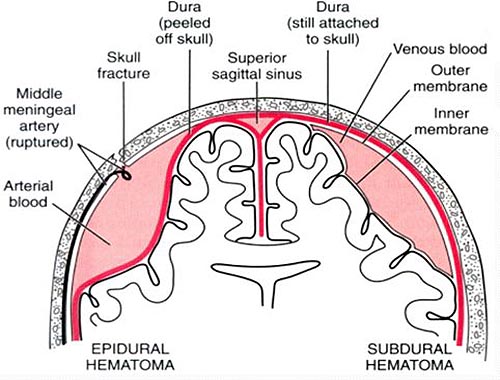Epidural Hematoma
Epidural hematoma is a traumatic accumulation of blood between the inner table of the skull and the stripped-off dural membrane. The inciting event often is a focused blow to the head, such as that produced by a hammer or baseball bat. In 85-95% of patients, this type of trauma results in an overlying fracture of the skull. Blood vessels in close proximity to the fracture are the sources of the hemorrhage in the formation of an epidural hematoma. Because the underlying brain has usually been minimally injured, prognosis is excellent if treated aggressively. Outcome from surgical decompression and repair is related directly to patient's preoperative neurologic condition. Hematoma is generally defined as a collection of blood outside of blood vessels. Most commonly, hematomas are caused by an injury to the wall of a blood vessel, prompting blood to seep out of the blood vessel into the surrounding tissues. A hematoma can result from an injury to any type of blood vessel (artery, vein, or small capillary). A hematoma usually describes bleeding which has more or less clotted, whereas a hemorrhage signifies active, ongoing bleeding. Hematoma is a very common problem encountered by many people at some time in their lives. Hematomas can be seen under the skin or nails as purplish bruises of different sizes. Skin bruises can also be called contusions. Hematomas can also happen deep inside the body where they may not be visible. Sometimes hematomas are named based on their location. Some examples include: Subdural hematoma: a hematoma between the brain tissue and the inside lining of the brain; Spinal epidural hematoma: a hematoma between spinal vertebrae and the outside lining of the spinal cord; Intracranial epidural hematoma: a hematoma between the skull and the outside lining of the brain; Subungual hematoma: a hematoma under the nail; Intra-abdominal, peritoneal, or retroperitoneal hematoma: a hematmoa inside the abdominal cavity; Ear or aural hematoma: a hematoma between the ear cartilage and overlying skin; Splenic hematoma: a hematoma within the spleen; Hepatic hematoma: a hematoma within the liver; Most hematomas resolve spontaneously over time as the blood debris is removed and the blood vessel wall is repaired by the body's repair mechanisms. Other times, removing or evacuating the blood in a hematoma becomes necessary based on its symptoms or location.
